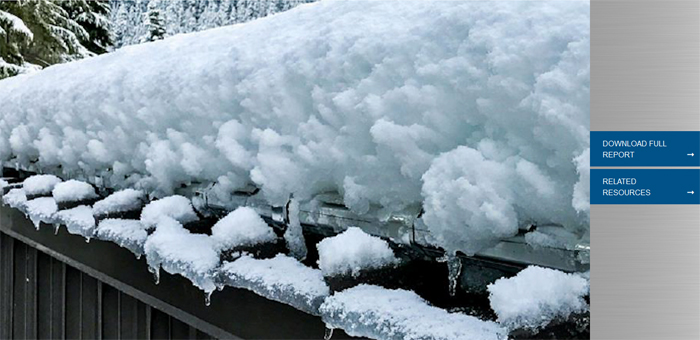Put Your (Snow) Guard Up: How To Prevent Rooftop Snow Avalanches

Portland, OR - Winter has barely begun, but freezing and sub-zero temperatures have already hit much of the U.S. and Canada. For homeowners, it's time to double check that your roof is ready for snow and ice. That's the advice coming from the
Metal Roofing Alliance (MRA), North America's leading resource
for metal roofing information for homeowners and residential roofing contractors.
The Metal Roofing Alliance (MRA) warns that when heavy snow accumulates on surfaces such as metal roofs that do not have quality snow guards installed correctly, the forces of nature can work to produce a rooftop avalanche. With the potential to release
thousands of pounds of snow accumulation in a split second, such an occurrence can severely harm and injure people and property unless proactive precautions are taken.
 |
Renee Ramey |
“Snow guards–which work to hold back rooftop snow and allow it to melt more gradually and predictably–are designed to prevent senseless tragedies from occurring. They are absolutely essential in areas that experience snowfall and freezing
temperatures,” said Renee Ramey, MRA Executive Director.
While snow guards may seem like a simple concept, a well-designed system is based on math and science, not guesswork. If basic engineering principles are not followed, snow retention systems can be rendered ineffective–an accident waiting to happen.
That’s why, when installing and designing an effective snow guard rooftop system, homeowners and their installers/snow guard designers should:
• Understand local snow loads: Contact your local building officials to get information on the ground snow loads in your area. A roof’s potential snow load can be calculated from the ground snow load information.
• Evaluate your roof’s characteristics: Your roof’s profile, material, slope, width of your panels, the rafter length (eave to ridge) and length of eaves help determine where your snow guards will be placed. Resources from industry
leaders such as S-5! can help you determine what the profile of your roof is, if you don’t know.
The company also offers a handy, easy-to-use Snow Guard Calculator available online. Additionally, S-5! offers the option to have the final computations stamped by a professional engineer and recognized for use in all 50 states.
• Approach placement with care: Snow guard placement should be well thought-out and prescribed by an experienced system designer or installer. To properly place snow retention systems, a clear understanding of roof geometries, how snow accumulates
and how snow behaves on a metal roof is necessary. As a general guideline, the entire eave line of a building should be protected, rather than focusing on an isolated area of the roof. For safety’s sake, avoid shortcuts such as placing snow
guards only above doorways, which can make snow load shedding even more unpredictable.
• Choose products you can count on: Primary snow guard system components should be fabricated from noncorrosive metals and have a life expectancy at least equivalent to the roof itself. Beware of any non-mechanically fastened, plastic components
or adhered products: none of these options have the proven ability to remain in service for the typical expected roof service life. Choose only products that offer proper gauge and testing verification.
Homeowners also need to be aware that even with the potential of danger, there are currently no building or governmental codes, standards or requirements for the proper installation and use of snow guards. That means, ensuring your installer or roofing
professional is using quality products from reputable manufacturers and following best practices set out by organizations such as the Metal Construction Association (MCA) is important. Download MCA’s “Qualifying Snow Retention Systems
For Metal Roofing” for free at https://metalconstruction.org/index.php/online-education/Snow-Retention
“With a little care and planning, a reliable, well-designed snow guard system can provide great peace of mind and protect your home and family during severe winter weather for many years to come,” said Ramey.
About The Metal Roofing Alliance
 Representing metal roofing manufacturers in the United States and Canada, the Metal Roofing Alliance (MRA) was formed in 1998 as a
nonprofit organization to help educate consumers about the many benefits of metal roofs. The main objective of MRA is to increase awareness of the beauty, durability and money-saving advantages of quality metal roofs among homeowners, as well as to
provide support for metal roofing businesses and contractors. For more information, visit
metalroofing.com.
Representing metal roofing manufacturers in the United States and Canada, the Metal Roofing Alliance (MRA) was formed in 1998 as a
nonprofit organization to help educate consumers about the many benefits of metal roofs. The main objective of MRA is to increase awareness of the beauty, durability and money-saving advantages of quality metal roofs among homeowners, as well as to
provide support for metal roofing businesses and contractors. For more information, visit
metalroofing.com.




